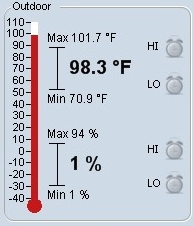
Critters Video, Clavius & Tycho Video, Saturn
Posted: 19 June 2013
 Very low relative humidity here on Tuesday, 18 June 2013, at 1700 MST, as seen on the right from the Cassiopeia Observatory weather station.
The observatory was opened at 1837 MST, 104°F. The sky was clear. At 1845 MST, viewed Venus with the 8" LX200-ACF at 83X. Then Mercury, 83X. The nice crescent phase was easily seen at 83X. Switched to 364X. Mercury illuminated portion was definitely thinner and fainter than on the previous evening. Also, I seemed to be seeing surface details again. At least, the terminator was not a smooth line.
Very low relative humidity here on Tuesday, 18 June 2013, at 1700 MST, as seen on the right from the Cassiopeia Observatory weather station.
The observatory was opened at 1837 MST, 104°F. The sky was clear. At 1845 MST, viewed Venus with the 8" LX200-ACF at 83X. Then Mercury, 83X. The nice crescent phase was easily seen at 83X. Switched to 364X. Mercury illuminated portion was definitely thinner and fainter than on the previous evening. Also, I seemed to be seeing surface details again. At least, the terminator was not a smooth line.
I took this photo of the moon at 1917 MST (21 minutes before sunset), D7000 DSLR, f/8, 1/125sec, ISO 100, 300mm:

I then saw that there were some visitors near the observatory:

Click (or tap) the above image to view a 21 second iPhone video (19 MB). Background music is from the Carl Sagan "Cosmos" TV show, playing on an iPod inside my POD.
Sunset occurred at 1938 MST. I began doing some prime focus + 2X Barlow Lens HD video recordings of the moon using the D7000 DSLR. I wanted to test image quality and magnification in preparation for next Tuesday's HST-Moon transit. Based on my tests (all underexposed), I have decided to stick with just prime focus for the transit, which is the same as I did for the previous successful HST-Moon transit imaging.
The craters Clavius and Tycho and the southern pole region appeared excellent, and so I captured a HD video of them at prime focus + 2X Barlow Lens, 1/200sec, ISO 1600:

Click (or tap) the above image to view a 10 second iPhone video (9.4 MB). Background music is also from the Carl Sagan "Cosmos" TV show, playing on the iPod inside the POD.
I then did a HD video of Saturn, prime focus + 2X Barlow Lens, 1/30sec, ISO 5000. 759 frames of the video were stacked using Keith's Image Stacker, with this result:

Imaging was ended at 2006 MST and I began preparing to close the observatory.
The observatory was closed at 2016 MST, 82°F.
As I left the observatory I saw Mercury and Venus in the western sky and took this D7000 DSLR photo, handheld, f/4.5, 1/15sec, ISO 1600, 70mm:

Mercury is just to the left of brighter Venus.
Comments are welcome; use the Comments section below, or you can Email Me. Thanks.
Cassiopeia Observatory Home Page